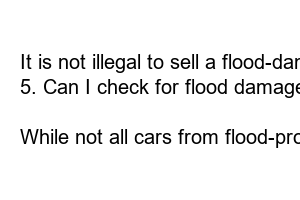침수차 확인하는 방법
How to Check for a Flood Car: A Comprehensive Guide
Have you ever considered purchasing a used car and wondered if it has been involved in a flood? Buying a flood-damaged car can lead to numerous issues and costly repairs, so it’s essential to know how to spot the signs. In this blog post, we will provide you with a step-by-step guide on how to check for a flood car before making a purchase.
1. Conduct a Visual Inspection
When inspecting a potential car, carefully examine both the interior and exterior for any visible signs of water damage. Look for water stains, musty odors, or dampness in the carpeting, upholstery, and trunk. Pay attention to the condition of the seats and dashboard as well, as any irregularities may indicate prior exposure to water.
2. Check the Electrical Components
Flood-damaged cars often experience issues with their electrical systems. Test all the lights, windows, wipers, radio, and other electronic features. Erratic behavior or malfunctions might indicate water damage that could lead to expensive repairs down the line.
3. Inspect the Engine and Transmission
Open the hood and inspect the engine compartment closely. Look for any signs of rust, mud, or debris in unusual areas. Additionally, check the transmission fluid for a milky appearance or a foul odor, as this can be a clear indicator of water contamination.
4. Look for Signs of Corrosion
Water can cause significant corrosion to a car’s metal components. Examine areas such as the brake lines, radiator, and battery terminals for any signs of rust or corrosion. These issues can lead to safety hazards and should not be overlooked.
5. Get a Professional Inspection
While conducting a visual inspection is essential, it’s also wise to have a trusted mechanic perform a thorough examination of the vehicle. They can assess the car’s mechanical and structural condition, giving you a more accurate evaluation of any flood damage.
6. Check the Vehicle History Report
Request a comprehensive vehicle history report from reputable sources like Carfax or AutoCheck. These reports often indicate if a car has been in a flood and offer other valuable information such as previous accidents, title status, and odometer readings.
Summary:
When buying a used car, it’s crucial to check for any damage caused by floods. Conduct a visual inspection, pay attention to electrical components, inspect the engine and transmission, look for signs of corrosion, and get a professional inspection. Additionally, obtain a detailed vehicle history report. By following these steps, you can make an informed decision and avoid potential headaches and financial losses.
Frequently Asked Questions (FAQs):
1. Can a flood-damaged car be repaired?
Yes, it is possible to repair a flood-damaged car, but the extent and cost of repairs can vary depending on the level of damage and how quickly the issue was addressed.
2. How much should I deduct from the price if I discover flood damage?
The deduction amount will depend on the severity of the damage, the car’s overall condition, and the local market. Consult with a mechanic or an expert to get an accurate estimation.
3. Are flood-damaged cars eligible for insurance coverage?
Insurance coverage for flood-damaged cars can be challenging to obtain. Many insurance companies consider them higher risks due to potential underlying issues, so coverage may be limited or more expensive.
4. Are flood-damaged cars illegal to sell?
It is not illegal to sell a flood-damaged car, but sellers are required to disclose this information to potential buyers.
5. Can I check for flood damage on a leased car?
Yes, whether you plan to buy or lease a car, it is essential to check for flood damage to avoid future complications.
6. Should I avoid purchasing a car from a flood-prone area?
While not all cars from flood-prone areas have flood damage, it is generally safer to be cautious and perform thorough inspections when considering a vehicle from such regions.

